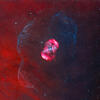HDR composit Image of the Sun

With exams starting this week, I've not had much time to do any deep-sky but I was able to create this image of the Sun using my new Quark filter and ASI 174mm!
This is an HDR (High Dynamic Range) composite image of the Sun, taken using the Daystar Quark Ha Chromosphere, ASI 174mm and William Optics z73 mounted on my old (but still very useful) skywatcher EQ3-pro mount.
To create this image, I used two separate images, one of the solar prominences, and the other of the chromosphere. I then combined the two images together to produce this HDR image!
For the image of the chromosphere, I first captured a 60s video using the ASI 174mm, making sure not to clip the histogram and ensuring no details were blown out. Similarly to planetary imaging, I then stacked the sharpest 15% of over 1000 images, extracted from that video and threw away the rest that were essentially blurred by the atmosphere. This produced a sharp, clean image of the Sun's surface, ready to be further processed.
For the prominence image, I used the same technique but simply increased the exposure and gain to reveal the much fainter details of the prominences. This blew out the Sun's surface but that was ok as I had a seperate image of the surface to add to this one.
With those 2 images, I carefully processed them, sharpening and adjusting them until I was happy with the result. This is what I ended up with! Let me know what you think of my image and if you have any advice or criticisms please do leave a comment below. Feel free to also share any of your images! I'd love to seem them and I'm sure others would too.
This blog post was originally published in our Telescope Live Community.
The Community represents Telescope Live's virtual living room, where people exchange ideas and questions around astrophotography and astronomy.
Join the conversation now to find out more about astrophotography and to improve your observation and post-processing skills!
